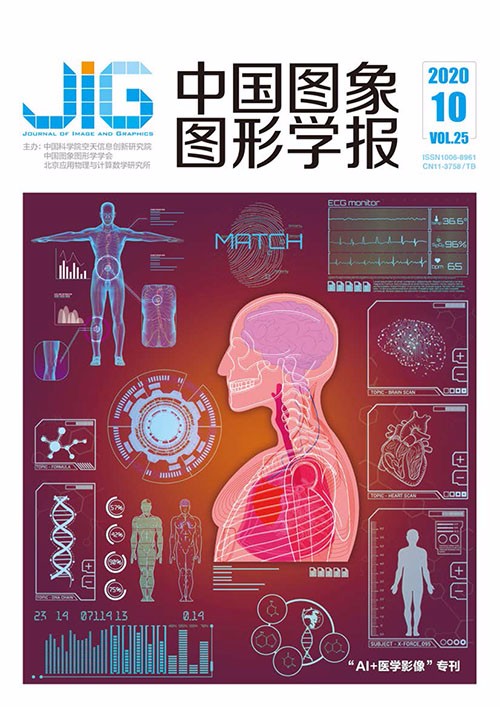
医学影像疾病诊断的残差神经网络优化算法研究进展
周涛1,2, 霍兵强1, 陆惠玲3, 师宏斌4(1.北方民族大学计算机科学与工程学院, 银川 750021;2.宁夏智能信息与大数据处理重点实验室, 银川 750021;3.宁夏医科大学理学院, 银川 750004;4.宁夏医科大学总医院泌尿外科, 银川 750004) 摘 要
残差神经网络(residual neural network,ResNet)及其优化是深度学习研究的热点之一,在医学图像领域应用广泛,在肿瘤、心脑血管和神经系统疾病等重大疾病的临床诊断、分期、转移、治疗决策和靶区勾画方面取得良好效果。本文对残差神经网络的学习优化进行了总结:阐述了残差神经网络学习算法优化,从激活函数、损失函数、参数优化算法、学习衰减率、归一化和正则化技术等6方面进行总结,其中激活函数的改进方法主要有Sigmoid、tanh、ReLU、PReLU(parameteric ReLU)、随机化ReLU(randomized leaky ReLU,RReLU)、ELU(exponential linear units)、Softplus函数、NoisySoftplus函数以及Maxout共9种;损失函数主要有交叉熵损失、均方损失、欧氏距离损失、对比损失、合页损失、Softmax-Loss、L-Softmax Loss、A-Softmax Loss、L2 Softmax Loss、Cosine Loss、Center Loss和焦点损失共12种;学习率衰减总结了8种,即分段常数衰减、多项式衰减、指数衰减、反时限衰减、自然指数衰减、余弦衰减、线性余弦衰减和噪声线性余弦衰减;归一化算法有批量归一化和提出批量重归一化算法;正则化方法主要有增加输入数据、数据增强、早停法、L1正则化、L2正则化、Dropout和Dropout Connect共7种。综述了残差网络模型在医学图像疾病诊断中的应用研究,梳理了残差神经网络在肺部肿瘤、皮肤疾病、乳腺癌、大脑疾病、糖尿病和血液病等6种疾病诊断中的应用研究;对深度学习在医学图像未来发展进行了总结和展望。
关键词
Progress of residual neural network optimization algorithm for medical imaging disease diagnosis
Zhou Tao1,2, Huo Bingqiang1, Lu Huiling3, Shi Hongbin4(1.School of Computer Science and Engineering, North Minzu University, Yinchuan 750021, China;2.Ningxia Key Laboratory of Intelligent Information and Big Data Processing, Yinchuan 750021, China;3.School of Science, Ningxia Medical University, Yinchuan 750004, China;4.Department of Urology, The General Hospital of Ningxia Medical University, Yinchuan 750004, China) Abstract
Residual neural network (ResNet) has gained considerable attention in deep learning research over the last few years and has made great achievements in computer vision. The deep convolutional network represented by ResNet is increasingly used in the field of medical imaging and has achieved good results in the clinical diagnosis, staging, metastasis, treatment decision, and target area delineation of major diseases, such as tumors, cardiovascular and cerebrovascular diseases, and nervous system diseases. The optimization of the ResNet algorithm is an important part of the ResNet research. It largely determines model performance, such as generalization and convergence. This article summarizes the learning optimization of ResNet. First, the optimization of the learning algorithm of ResNet is elaborated, and the six aspects of activation function, loss function, parameter optimization algorithm, learning decay rate algorithm, normalization, and regularization are summarized. Nine improvement methods exist for the activation function; they are sigmoid, tanh, ReLU, PReLU, randomized ReLU, exponential linear units(ELU), softplus function, noisy softplus function, and maxout. The loss function includes 12 types: cross-entropy, mean square, Euclidean distance, contrast, hinge, softmax, L-softmax, A-softmax, L2 softmax, cosine, center, and focus losses. Eight learning rate decay methods, namely, piecewise constant, polynomial, exponential, inverse time, natural exponential, cosine, linear cosine, and noise linear cosine, are summarized. The normalization algorithms include batch normalization and renormalization. The regularization technologies include seven types: input data, data enhancement, early stop method, L1 regularization, L2 regularization, dropout, and dropout connect. Second, the application study of the residual network model in the diagnosis of medical imaging diseases is reviewed. ResNet is used to diagnose six types of diseases: lung tumor, skin disease, breast cancer, brain disease, diabetes, and hematological disease. 1) Lung cancer. Considerable data show that the incidence of lung cancer is increasing yearly, which is a serious threat to human health. Early diagnosis and detection are essential for the treatment of lung cancer. The main contributions of ResNet in lung tumor research are particle swarm optimization(PSo)+convolutional neural network(CNN), intermediate dense projection method+DenseNet, DenseNet+fully convolutional network(FCN), attention mechanism+ResNet, dense network+U-Net, and 3D+CNN. 2) Skin cancer. Malignant melanoma is one of the most common and deadly skin cancers. Melanoma can be cured if it is properly treated in the early stage. The main contributions of ResNet in the diagnosis and research of skin diseases are integrated learning+CNN, multichannel ResNet, ResNet+support vector machine(SVM), integrated learning+ResNet, and whale optimization algorithm+CNN. 3) Breast cancer. It is a malignant tumor in women, which seriously affects their physical and mental health. The main contributions of ResNet in the diagnosis and research of breast cancer include transfer learning+ResNet, decision tree+ResNet, CNN+SVM, DesneNet-II, and SE-attention+CNN. 4) Alzheimer's disease (AD). It is an irreversible brain disease accompanied with progressive impairment of memory and cognitive functions. No effective cure method exists for AD. Early diagnosis of AD is particularly important for patient care and treatment. The main contributions of ResNet in the diagnosis and research of brain diseases are DenseNet, multiscale ResNet, 3DResNet, and multitask CNN+3D DenseNet. 5) Diabetic retinopathy (glycemic retinopathy). It is an eye disease induced by long-term diabetes, which will cause the patient to lose sight and eventually lead to blindness. The main contributions of ResNet in relevant diagnosis and research are migration learning+CNN, FCN+ResNet, multicategory ResNet, and ResNet+SVM. 6) Blood diseases. The proportion of white blood cells in liquid is usually an indicator of diseases. The classification and counting of white blood cells are used in the process of diagnosing diseases. White blood cell test plays a vital role in the detection and treatment of leukemia, anemia, and other diseases. The main contributions of ResNet in the diagnosis and research of blood diseases are as follows: deep supervision ResNet, fine-tuned ResNet, deep cross ResNet, and deep supervision FCN. Lastly, the future development of deep learning in medical imaging is summarized. In this paper, the algorithms of ResNet are systematically summarized, which has a positive significance to the research and development of ResNet.
Keywords
deep learning residual neural network(ResNet) optimization algorithm medical image disease diagnosis
|



 中国图象图形学报 │ 京ICP备05080539号-4 │ 本系统由
中国图象图形学报 │ 京ICP备05080539号-4 │ 本系统由